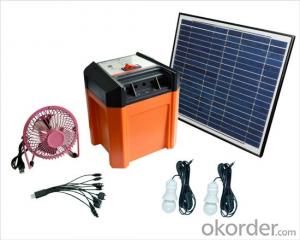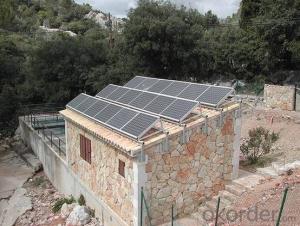SOLAR POWER SYSTEM +Built-in battery +USB
- Loading Port:
- Shekou
- Payment Terms:
- TT OR LC
- Min Order Qty:
- 50 unit
- Supply Capability:
- 5000 unit/month
OKorder Service Pledge
OKorder Financial Service
You Might Also Like
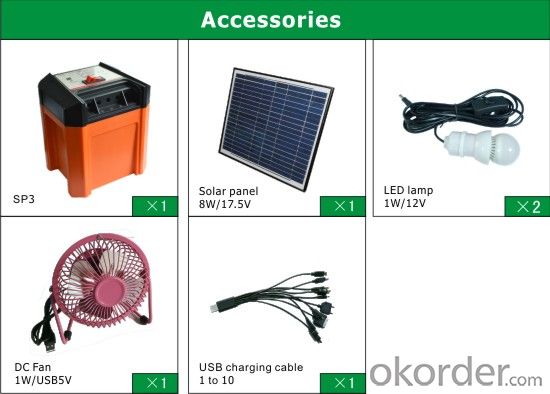
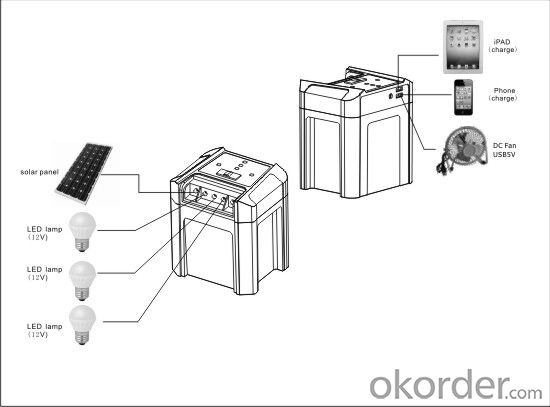
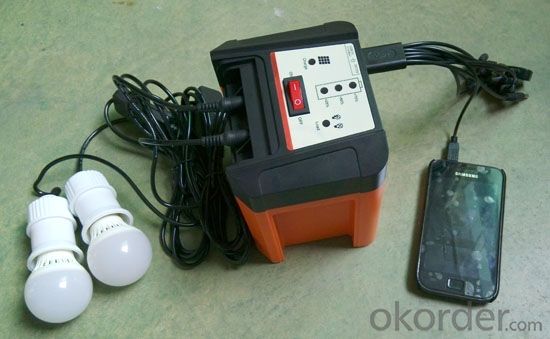
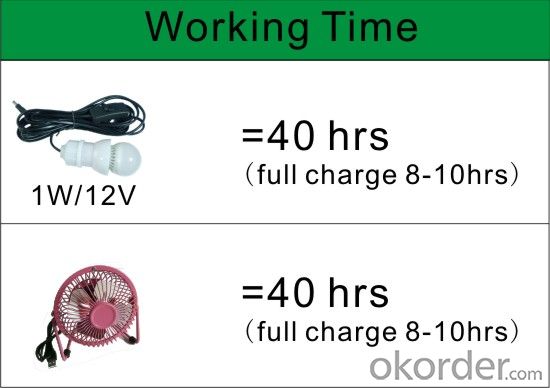
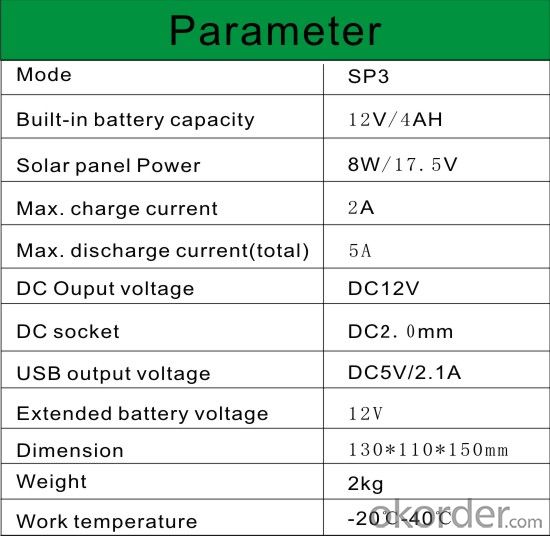
This system designed to provide DC power supply for power lighting,mobile phone charging,run the DC Fan and Radio,etc
Built-in maintenance-free Lead-acid battery
Adopt the latest PWM Control modulation,real time display of battery capacity and load status.
With several output socket,can output voltage DC 12V and DC 5V at the same time.
It can charged by solar panel
Voice warning and together LED indicator shows the battery get low.
Bulit-in battery capacity:12V/4AH
Solar panel power:8W/17.5V
Max.discharge current(total):5A
Max.charge current:2A
DC Output voltage:DC12V
Weight:2KG
Work temperature:-20-40
USB output voltage:DC5V/2.1A
DC socket:DC2.5mm
- Q:Can solar energy systems be used in areas with limited access to technical expertise?
- Yes, solar energy systems can be used in areas with limited access to technical expertise. The design and installation of solar energy systems have become increasingly user-friendly and accessible over time. There are now simplified and plug-and-play solar kits available that can be easily installed and maintained by individuals with limited technical knowledge. Additionally, organizations and initiatives are providing training and educational resources to empower local communities in these areas to adopt and manage solar energy systems effectively.
- Q:What is the impact of solar energy systems on air quality?
- Air quality is positively impacted by solar energy systems. In contrast to coal or natural gas, solar energy does not emit harmful substances or pollutants while operating. This means that solar power does not contribute to the release of greenhouse gases, particulate matter, sulfur dioxide, nitrogen oxide, or any other air pollutants associated with burning fossil fuels. Through the utilization of solar energy systems, we can greatly decrease our dependence on fossil fuels, leading to a reduction in air pollution levels. This has numerous advantages for human health and the environment. Improved air quality can result in lower rates of respiratory and cardiovascular diseases, as well as a decrease in respiratory symptoms and allergies. Moreover, solar energy systems aid in the overall reduction of smog, acid rain, and the potential for global warming. Additionally, the installation and use of solar energy systems do not generate noise pollution, which is another significant benefit compared to traditional energy sources. This reduction in noise pollution has positive effects on the well-being and overall quality of life for individuals living near solar installations. In conclusion, the adoption of solar energy systems is a crucial step in improving air quality and mitigating the adverse effects of climate change. By harnessing the power of the sun, we can substantially decrease air pollution, promote cleaner and healthier environments, and create a more sustainable future for future generations.
- Q:Are there any environmental benefits of solar energy systems?
- Yes, there are numerous environmental benefits of solar energy systems. Firstly, solar energy is a clean and renewable energy source, meaning it does not emit greenhouse gases or other harmful pollutants into the atmosphere. This helps to reduce air pollution and combat climate change, as solar power generates electricity without any carbon emissions. Moreover, solar energy systems require minimal water usage compared to other traditional forms of energy generation, such as coal or natural gas power plants. This is particularly important in regions facing water scarcity or droughts, as solar power helps to conserve water resources. Additionally, solar energy systems help to reduce reliance on fossil fuels, which are finite resources and contribute to the depletion of natural resources. By generating electricity from sunlight, solar power reduces the need for extracting and burning fossil fuels, conserving these valuable resources for future generations. Furthermore, solar energy systems can be installed on rooftops or in open areas, minimizing the need for large-scale land clearance or habitat destruction. This helps to protect ecosystems and preserve biodiversity. Overall, solar energy systems offer significant environmental benefits by reducing greenhouse gas emissions, conserving water resources, minimizing reliance on fossil fuels, and preserving ecosystems. By transitioning to solar power, we can contribute to a cleaner, more sustainable future for our planet.
- Q:Can solar energy systems be used in powering research farms or agricultural laboratories?
- Yes, solar energy systems can certainly be used to power research farms or agricultural laboratories. Solar panels can generate electricity which can be used to power various equipment and machinery used in these facilities, such as irrigation systems, lighting, climate control systems, and other electrical devices. By utilizing solar energy, these agricultural facilities can reduce their reliance on fossil fuels and significantly lower their operational costs while also contributing to a more sustainable and environmentally friendly approach to farming and research.
- Q:Can a solar energy system be installed in an area with a high earthquake risk?
- It is entirely possible to install a solar energy system in an area prone to earthquakes, but it requires meticulous planning and engineering to ensure its stability and ability to withstand seismic activities. When installing a solar energy system in an earthquake-prone region, it is essential to consider the unique requirements of the area and adhere to local building codes and regulations. These codes often provide guidelines and specifications for constructing structures that can endure the forces of an earthquake. To minimize the risks associated with earthquakes, several measures can be taken during the installation process: 1. Foundation Design: The solar energy system must have a sturdy foundation specifically designed to withstand ground shaking. Properly anchoring the system will prevent it from toppling or sliding during an earthquake. 2. Structural Design: The structural components of the solar energy system, such as mounting frames and supports, should be engineered to endure seismic forces. Additional reinforcements like bracing or crossbars can be added to enhance stability. 3. Flexible Wiring: Electrical wiring within the solar energy system should be installed using flexible conduit and connectors. This ensures that the system can move during an earthquake without causing damage or electrical failures. 4. Maintenance and Inspections: Regular maintenance and inspections are essential to identify any potential weaknesses or damage to the solar energy system. Prompt repairs or reinforcements can then be carried out, reducing the risk of failure during an earthquake. By adhering to these guidelines and collaborating closely with experienced engineers and solar energy professionals, it is possible to install a solar energy system in an earthquake-prone area. This not only facilitates the utilization of clean and renewable energy but also contributes to the resilience and sustainability of the local energy infrastructure.
- Q:What is the lifespan of a solar energy system?
- The lifespan of a solar energy system typically ranges from 25 to 30 years.
- Q:Can solar energy systems be used for powering industrial processes?
- Certainly, industrial processes can be powered by solar energy systems. In recent years, solar power has gained popularity as a sustainable and renewable energy source. The energy demands of industrial processes are often substantial, and solar power can be harnessed to meet these requirements. There are various ways in which solar energy systems can be utilized for industrial processes. One common approach involves installing solar photovoltaic (PV) panels. These panels convert sunlight directly into electricity, which can then be used to power industrial machinery and equipment. By integrating solar PV systems into existing infrastructure, industries can reduce their reliance on traditional fossil fuels and decrease their carbon footprint. In addition to generating electricity, solar thermal systems can also be employed to power industrial processes. Solar thermal technology uses the sun's heat to produce steam, which can then drive turbines or provide direct heat for industrial applications. This method is particularly beneficial for industries that require high-temperature processes, such as manufacturing, chemical production, or food processing. Implementing solar energy systems for industrial processes offers numerous advantages. Firstly, it helps to mitigate greenhouse gas emissions and combat climate change. Solar power is a clean energy source that emits no harmful pollutants or greenhouse gases during operation. By transitioning to solar energy, industries can contribute to a more sustainable and environmentally friendly future. Furthermore, utilizing solar power can lead to long-term energy cost savings for industries. Although the initial investment for installing solar energy systems may be significant, the operational costs are considerably lower compared to traditional energy sources. Once the systems are in place, industries can benefit from reduced electricity bills and even generate excess energy that can be sold back to the grid. Lastly, solar energy systems provide a reliable and resilient power source. They can function even in remote areas or during power outages, ensuring uninterrupted production processes. Additionally, solar panels have a long lifespan and require minimal maintenance, making them a viable long-term solution for industrial power needs. In conclusion, solar energy systems can indeed be utilized for powering industrial processes. With advancements in solar technology and an increasing emphasis on sustainability, more and more industries are embracing solar power to meet their energy demands. By harnessing the sun's energy, industries can reduce their environmental impact, save on energy costs, and ensure a reliable and resilient power supply for their industrial processes.
- Q:What is a photovoltaic (PV) system?
- A photovoltaic (PV) system is a technology that converts sunlight into electricity using solar panels made up of photovoltaic cells. These cells generate a direct current (DC) electrical current when exposed to sunlight, which is then converted into alternating current (AC) by an inverter for use in homes, buildings, or the power grid. PV systems are a clean and renewable energy source that can be used for various applications, from powering individual devices to supplying electricity for entire communities.
- Q:How does solar energy compare to other renewable energy sources like wind or hydro power?
- Solar energy, like wind and hydro power, is a crucial renewable energy source. However, it has its own unique advantages and disadvantages when compared to other renewables. Solar energy is abundant, easily accessible, and can be harnessed almost anywhere. While wind power may have the potential to generate more electricity, solar energy is more consistent and reliable. Similarly, hydro power is more efficient in terms of energy production, but it is limited by geographical constraints. Ultimately, the choice between these renewable sources depends on specific circumstances, such as location, available resources, and energy demands.
- Q:What is the impact of temperature on solar energy system performance?
- The impact of temperature on solar energy system performance is twofold. Firstly, as temperature increases, the efficiency of solar panels decreases. Higher temperatures can cause the panels to overheat, leading to a reduction in their power output. Secondly, temperature affects the overall performance of the system, including the inverter and wiring. Extreme temperatures can cause degradation and damage to these components, potentially leading to a decrease in the overall system efficiency. Therefore, it is important to consider temperature management and cooling mechanisms to optimize the performance of solar energy systems.
1. Manufacturer Overview |
|
|---|---|
| Location | |
| Year Established | |
| Annual Output Value | |
| Main Markets | |
| Company Certifications | |
2. Manufacturer Certificates |
|
|---|---|
| a) Certification Name | |
| Range | |
| Reference | |
| Validity Period | |
3. Manufacturer Capability |
|
|---|---|
| a)Trade Capacity | |
| Nearest Port | |
| Export Percentage | |
| No.of Employees in Trade Department | |
| Language Spoken: | |
| b)Factory Information | |
| Factory Size: | |
| No. of Production Lines | |
| Contract Manufacturing | |
| Product Price Range | |
Send your message to us
SOLAR POWER SYSTEM +Built-in battery +USB
- Loading Port:
- Shekou
- Payment Terms:
- TT OR LC
- Min Order Qty:
- 50 unit
- Supply Capability:
- 5000 unit/month
OKorder Service Pledge
OKorder Financial Service
Similar products
New products
Hot products
Hot Searches
Related keywords
